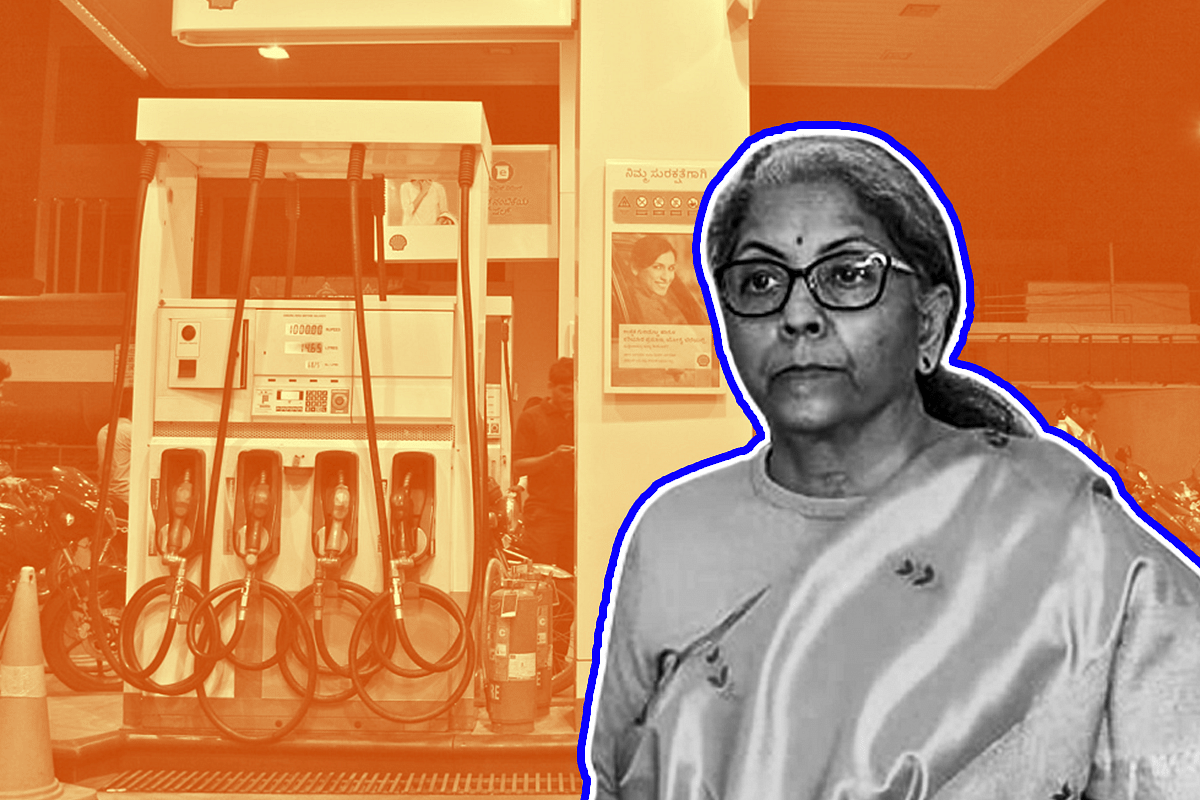Economy
Memo To Finance Minister On Petrol Spike: Don’t Cut Taxes, But Share More Of It With States
- Don’t cut taxes, but share more of it with the states.
- If a cut has to be done at some future date to provide some relief to consumers, both the Centre and states should cut equal amounts.

Finance Minister Nirmala Sitharaman.
With pump prices of petrol crossing the psychologically important barrier of Rs 100 per litre – currently only in Rajasthan, but more states could head that way – there is little doubt that fuel price spikes will become another political flashpoint between the Centre and states.
Even though both the Centre and states are equal opportunity offenders when it comes to levying high taxes on a product with almost inelastic demand, the protests will become anti-Centre largely because one fundamental factor has changed in the Narendra Modi years: the Centre has been levying more petro-taxes through cesses and surcharges, which do not form part of the divisible tax pool in which states get a share.
Before we get to that, let’s understand the broad structure and math of petro-taxation. The Centre collects its taxes through customs duties, excise, additional excise and cesses, which currently add up to nearly Rs 33 per litre of petrol and Rs 32 for diesel. A year ago, the taxes were in the region of Rs 20 and Rs 16 respectively.
On the other hand, states levy both ad valorem (value-added) taxes and fixed cesses. An ad valorem tax is levied in percentage terms, and thus when the basic prices of petrol change, states earn more even without raising the VAT (value-added tax) rate.
In Rajasthan, which hit the Rs 100 mark in petrol prices (in Sriganganagar on 17 February), the value-added tax rate is 36 per cent on petrol and 26 per cent on diesel. Then, there is an additional Rs 1.50 road cess on petrol, and Rs 1.75 on diesel. In Maharashtra, VAT is 25 per cent and 21 per cent, but cesses are higher at Rs 10 and Rs 3 on petrol and diesel.
A simple point: neither the Centre nor states is entirely honest in how taxes are levied. There is a cascade.
Net result: according to data from the Petroleum Planning and Analysis Cell (PPAC), during the last six-and-odd years after the Modi government came to power (2014-15 to the first half of 2020-21), the Centre earned Rs 19.33 lakh crore from petro-taxes, corporate taxes, royalties and dividends from petroleum companies. States earned Rs 12.5 lakh crore during the same period, plus a 42 per cent share of the taxes that went into the divisible pool (basically customs duty, and corporate taxes paid).
The skew is clearly towards the Centre keeping more of its taxes earned from cesses and surcharges – which is a sore point with states. This is why it is going to become a Centre-state issue, even though both tax the petroleum sector heavily.
The 15th Finance Commission wants the Centre to share 41 per cent of its divisible pool of taxes with states, but one expert quoted by The Economic Times puts the actual shareable revenue pool at 30 per cent, or thereabouts, once non-shareable levies like cesses and surcharges are excluded from the Centre’s total tax revenues.
Put simply, the Centre is guarding its kitty from spilling over into the divisible pool and protecting its own revenue base.
The obvious way out of the crisis is not necessarily to cut taxes, but for the Centre to put more of its petro-tax collections in the divisible pool, or to offer a specified percentage of its non-divisible pool as general cash grants to states.
Cutting taxes, when the country imports 85 per cent of its crude oil, is not a good idea unless crude prices reach unbearable levels.
For three reasons: one, it is not in national interest to make oil cheap, which will only boost domestic consumption and make us more import-dependent than now.
Two, high oil taxes are environmentally friendly, since they play the role of carbon taxes.
Three, high petroleum prices make renewable sources of energy more viable to invest in.
The bottom line: don’t cut taxes, but share more of it with the states. If a cut has to be done at some future date to provide some relief to consumers, both the Centre and states should cut equal amounts.
Support Swarajya's 50 Ground Reports Project & Sponsor A Story
Every general election Swarajya does a 50 ground reports project.
Aimed only at serious readers and those who appreciate the nuances of political undercurrents, the project provides a sense of India's electoral landscape. As you know, these reports are produced after considerable investment of travel, time and effort on the ground.
This time too we've kicked off the project in style and have covered over 30 constituencies already. If you're someone who appreciates such work and have enjoyed our coverage please consider sponsoring a ground report for just Rs 2999 to Rs 19,999 - it goes a long way in helping us produce more quality reportage.
You can also back this project by becoming a subscriber for as little as Rs 999 - so do click on this links and choose a plan that suits you and back us.
Click below to contribute.
Latest